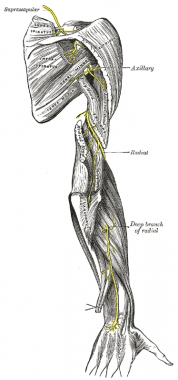

Radial neuropathies result from injury due to penetrating wounds or fractures of the arm, compression, or ischemia. Most commonly, they present with a wrist drop. The pattern of clinical involvement is dependent on the level of injury.
Radial neuropathies can occur from surgical procedures such as humeral nailing performed to stabilize an acute humeral fracture.[1]
The terms Saturday night palsy and honeymooner's palsy refer to the concept of placing one's arm over another chair, with the resultant pressure causing injury to the radial nerve.
NextAn introduction to radial nerve anatomy is essential for understanding the common mechanisms and location of its injury. The radial nerve branches from the posterior cord of the brachial plexus. It receives root innervation from C5-T1 spinal roots. In the upper arm, the radial nerve gives off a branch to the triceps muscle before it wraps around the humerus at the spiral groove. Three sensory branches, which supply the skin over the triceps and posterior forearm, also are given off at this level. Here, its proximity to the humerus makes it susceptible to compression and/or trauma.
After exiting the spiral groove, the radial nerve supplies the brachioradialis muscle before dividing into the posterior interosseous branch and a sensory branch. The posterior interosseous branch is a pure motor nerve that supplies the supinator. It then dives into the supinator through the fascia to supply the muscles of the wrist and finger extension. This fascia is another common site for nerve damage to occur. The sensory branch that arises approximately at the elbow travels down the forearm, becoming superficial at the wrist before it supplies the lateral aspect of the dorsum of the hand. See the image below.
 The Radial Nerve from Gray's Anatomy (published 1918, public domain, copyright expired).
The Radial Nerve from Gray's Anatomy (published 1918, public domain, copyright expired). United States
Radial neuropathy is the fourth most common mononeuropathy.
No racial preponderance is known.
No gender predilection has been observed.
Radial neuropathy is reported in all age groups.
Clinical Presentation
Copyright © www.orthopaedics.win Bone Health All Rights Reserved